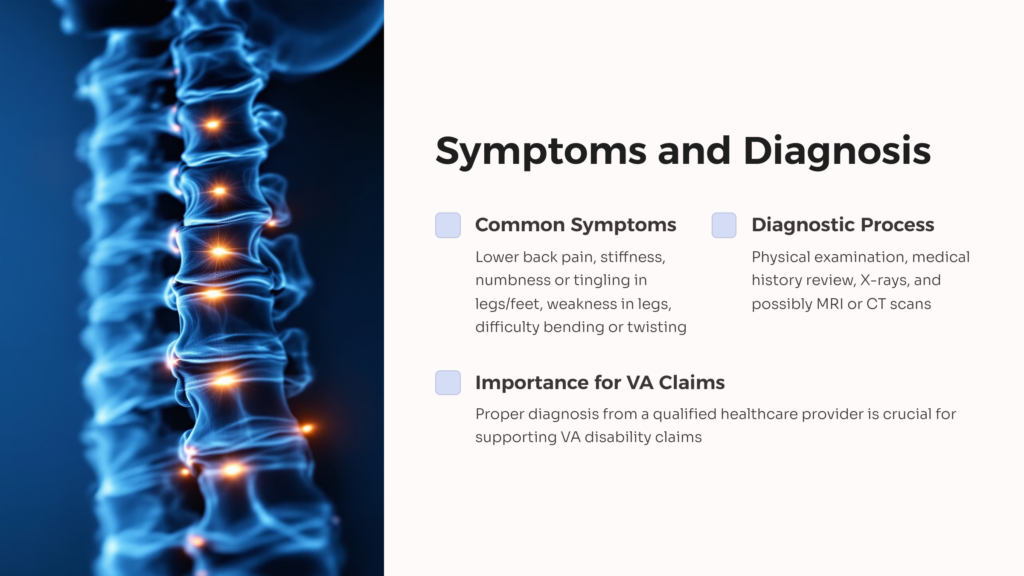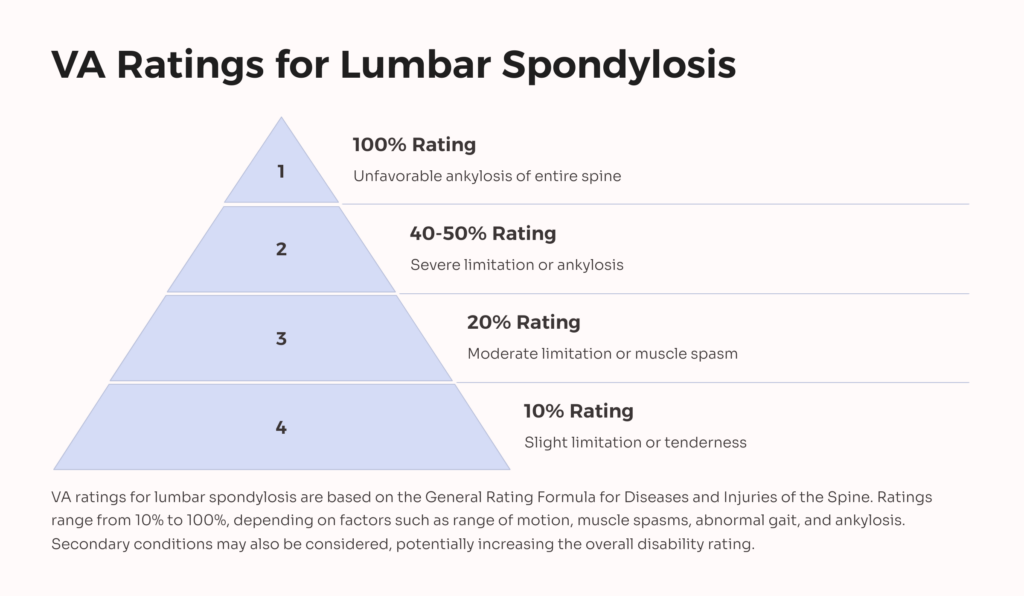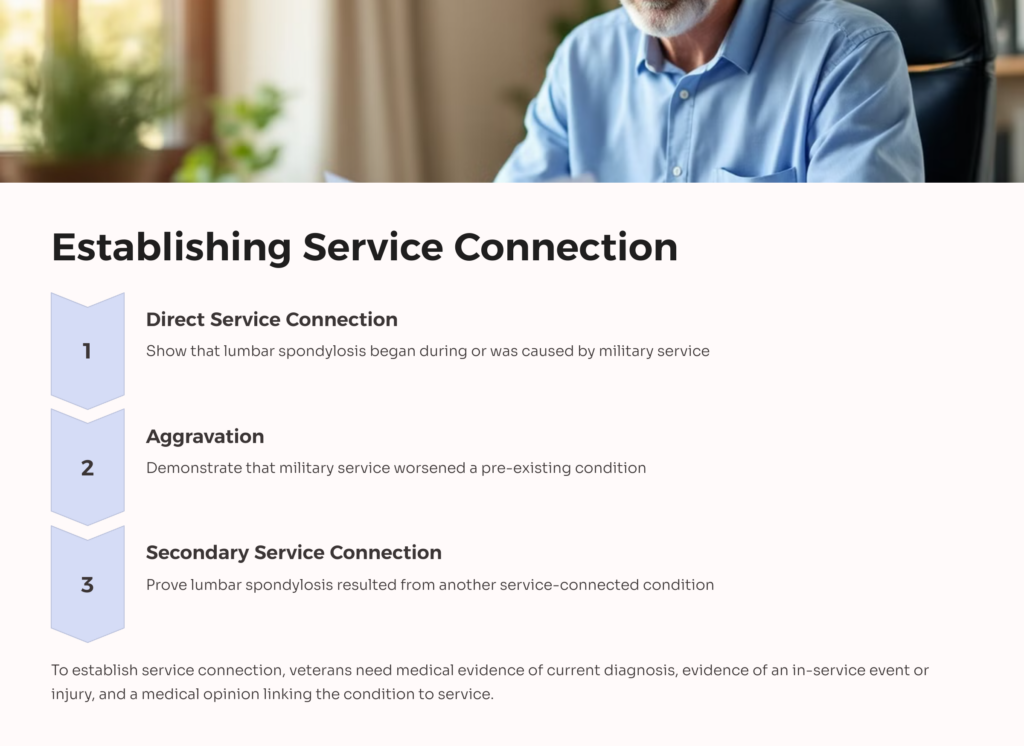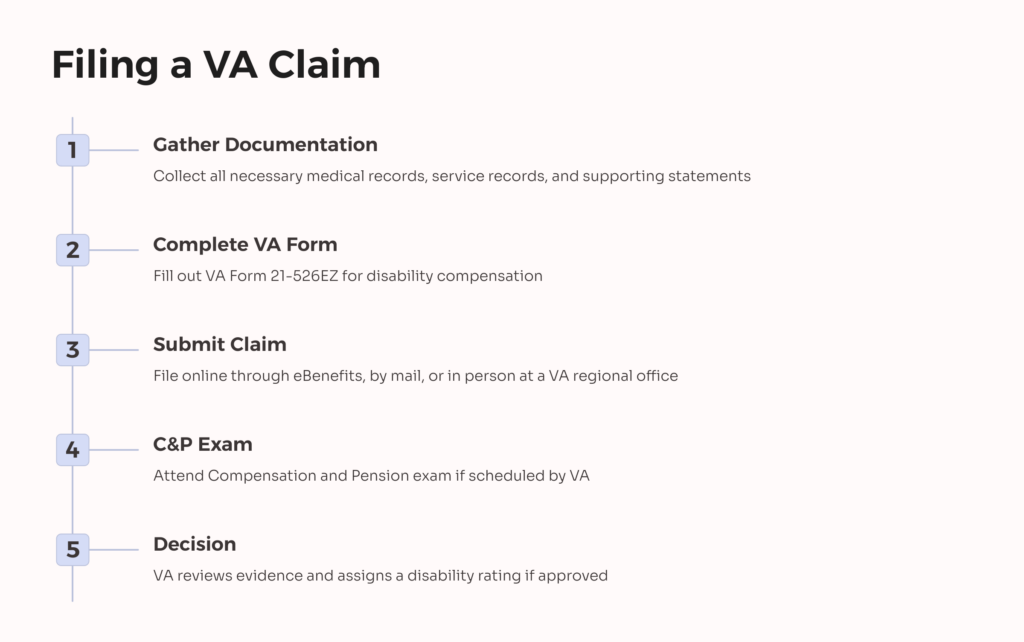Lumbar spondylosis is a common condition that affects the lower back, particularly in older adults and veterans. It’s a type of arthritis that occurs in the spine, specifically in the lumbar region. This condition involves the wear and tear of the vertebrae and discs in the lower back, leading to various symptoms and potential disabilities.
For veterans, lumbar spondylosis can be a significant issue, often resulting from years of physical strain during military service. The condition can develop gradually over time or may be accelerated by injuries sustained during active duty. Understanding lumbar spondylosis is crucial for veterans seeking VA benefits and proper medical care.
It’s important to note that lumbar spondylosis is different from other spine conditions like herniated discs or spinal stenosis, though these conditions can sometimes occur together. The VA recognizes lumbar spondylosis as a potentially service-connected disability, which means veterans may be eligible for compensation if the condition is related to their military service.
Symptoms and Diagnosis of Lumbar Spondylosis

The symptoms of lumbar spondylosis can vary widely among individuals. Some common signs include:
- Lower back pain that may radiate to the buttocks or legs
- Stiffness in the lower back, especially in the morning or after periods of inactivity
- Numbness or tingling in the legs or feet
- Weakness in the legs
- Difficulty bending or twisting the lower back
To diagnose lumbar spondylosis, doctors typically start with a physical examination and a review of the patient’s medical history. They may ask about the nature of the pain, when it started, and any activities that make it better or worse. X-rays are often used to visualize the spine and look for signs of degeneration.
In some cases, more advanced imaging tests like MRI or CT scans may be necessary to get a clearer picture of the spine and rule out other conditions. These tests can show details of the soft tissues, including the spinal cord and nerves, which can be affected by lumbar spondylosis.
For veterans seeking a VA rating for lumbar spondylosis, getting a proper diagnosis from a qualified healthcare provider is crucial. This diagnosis will be an important part of the evidence needed to support a VA claim for disability benefits.
Understanding VA Ratings for Lumbar Spondylosis

The VA uses a rating system to determine the level of disability and compensation for veterans with service-connected conditions like lumbar spondylosis. These ratings are based on the severity of the condition and its impact on the veteran’s daily life and ability to work.
For lumbar spondylosis, the VA typically rates the condition under the General Rating Formula for Diseases and Injuries of the Spine. Ratings can range from 10% to 100%, depending on factors such as:
- Range of motion in the spine
- Presence of muscle spasms or guarding
- Abnormal gait or spinal contour
- Ankylosis (fusion of the spine)
- Incapacitating episodes
It’s important to understand that the VA may also consider secondary conditions caused by lumbar spondylosis, such as radiculopathy (nerve pain) or depression, which could potentially increase the overall disability rating.
Veterans should be aware that the VA rating process can be complex, and it’s often beneficial to seek assistance from a Veterans Service Organization or a VA-accredited attorney when navigating the system.
How to Get Service Connected for Lumbar Spondylosis

To receive VA benefits for lumbar spondylosis, veterans must establish a service connection for the condition. This means proving that the condition is related to their military service. There are several ways to establish a service connection:
1. Direct Service Connection: The veteran can show that the lumbar spondylosis began during or was caused by military service.
2. Aggravation: If the condition existed before service, the veteran can show that military service worsened the condition beyond its natural progression.
3. Secondary Service Connection: The veteran can demonstrate that the lumbar spondylosis is a result of another service-connected condition.
To establish a service connection, veterans will need to provide:
- Medical evidence of a current diagnosis of lumbar spondylosis
- Evidence of an in-service event, injury, or illness that could have caused or contributed to the condition
- A medical opinion linking the current condition to the in-service event (often called a “nexus” letter)
It’s crucial to gather all relevant medical records, both from military service and after, to support the claim. Statements from fellow service members or family members who can attest to the onset or worsening of symptoms can also be helpful.
Filing a VA Claim for Lumbar Spondylosis

Filing a VA claim involves several steps:
1. Gather all necessary documentation, including medical records, service records, and any supporting statements.
2. Complete VA Form 21-526EZ, Application for Disability Compensation and Related Compensation Benefits.
3. Submit the form and all supporting documents to the VA. This can be done online through the VA’s eBenefits portal, by mail, or in person at a VA regional office.
4. The VA will review the claim and may schedule a Compensation and Pension (C&P) exam to assess the severity of the condition.
5. After reviewing all evidence, the VA will make a decision on the claim and assign a disability rating if the claim is approved.
It’s important to be thorough and accurate when filling out the claim form. Any inconsistencies or missing information could delay the process or lead to a denial of the claim. Veterans should also be prepared for the possibility that the VA may request additional information or clarification during the claims process.
Remember, the goal is to provide a clear and compelling case for how lumbar spondylosis is connected to military service and how it impacts daily life. Being detailed and specific in describing symptoms and limitations can help ensure a fair evaluation of the claim.
Compensation and Pension (C&P) Exam for Lumbar Spondylosis
The Compensation and Pension (C&P) exam is a crucial part of the VA’s evaluation process for lumbar spondylosis claims. This exam is conducted by a VA-appointed healthcare provider and is designed to assess the severity of the condition and its impact on the veteran’s life.
During the C&P exam, the examiner will:
- Review the veteran’s medical history and claims file
- Perform a physical examination, which may include range of motion tests
- Ask questions about symptoms, limitations, and how the condition affects daily activities
- Possibly order additional tests if needed
It’s important for veterans to be honest and thorough during the C&P exam. They should clearly communicate how lumbar spondylosis affects their daily life, including any difficulties with work, household chores, or recreational activities. Veterans should also be prepared to discuss the frequency and severity of flare-ups, if applicable.
After the exam, the examiner will write a report that the VA will use to help determine the disability rating. Veterans have the right to request a copy of this report, and it’s often a good idea to do so to ensure all information is accurate and complete.
VA Rating Criteria for Lumbar Spondylosis
The VA uses specific criteria to rate lumbar spondylosis, primarily based on the General Rating Formula for Diseases and Injuries of the Spine. Here’s a simplified breakdown of the rating criteria:
- 10% rating: Forward flexion of the thoracolumbar spine greater than 60 degrees but not greater than 85 degrees; or combined range of motion of the thoracolumbar spine greater than 120 degrees but not greater than 235 degrees; or muscle spasm, guarding, or localized tenderness not resulting in abnormal gait or abnormal spinal contour.
- 20% rating: Forward flexion of the thoracolumbar spine greater than 30 degrees but not greater than 60 degrees; or the combined range of motion of the thoracolumbar spine not greater than 120 degrees; or muscle spasm or guarding severe enough to result in an abnormal gait or abnormal spinal contour.
- 40% rating: Forward flexion of the thoracolumbar spine 30 degrees or less; or favorable ankylosis of the entire thoracolumbar spine.
- 50% rating: Unfavorable ankylosis of the entire thoracolumbar spine.
- 100% rating: Unfavorable ankylosis of the entire spine.
It’s important to note that these ratings can be affected by additional factors such as pain, weakness, fatigue, and lack of endurance. The VA is required to consider these factors when determining the final rating.
Veterans should also be aware that if they experience neurological symptoms related to their lumbar spondylosis, such as sciatica, these may be rated separately and combined with the spine rating for a potentially higher overall disability rating.
Common Mistakes to Avoid When Filing a Claim
When filing a VA claim for lumbar spondylosis, there are several common mistakes that veterans should avoid:
1. Insufficient medical evidence: Not providing enough medical documentation to support the claim is a frequent issue. Ensure all relevant medical records are included with the claim.
2. Lack of nexus: Failing to establish a clear link between military service and the current condition can lead to a denial. A strong nexus letter from a healthcare provider can be crucial.
3. Underreporting symptoms: Some veterans may downplay their symptoms out of habit or stoicism. It’s important to be honest and thorough about how the condition affects daily life.
4. Missing deadlines: The VA has specific timeframes for responding to requests for information. Missing these deadlines can delay or derail a claim.
5. Inconsistent statements: Providing conflicting information about the condition or its onset can harm the credibility of the claim. Be consistent in all communications with the VA.
6. Not seeking professional help: Navigating the VA claims process can be complex. Many veterans benefit from the assistance of a Veterans Service Organization or a VA-accredited attorney.
By avoiding these common pitfalls, veterans can improve their chances of a successful claim for lumbar spondylosis VA benefits.
How to Appeal a Denied Claim
If a VA claim for lumbar spondylosis is denied, veterans have the right to appeal the decision. The appeals process has changed in recent years with the implementation of the Appeals Modernization Act (AMA). Under the new system, veterans have three options for appealing a decision:
1. Higher-Level Review: A senior VA reviewer will take a fresh look at the claim. No new evidence can be submitted with this option.
2. Supplemental Claim: This allows veterans to submit new and relevant evidence to support their claim.
3. Appeal to the Board of Veterans’ Appeals: This is a direct appeal to the Board, where veterans can choose between a direct review, submission of additional evidence, or a hearing with a Veterans Law Judge.
When appealing a denied claim, it’s crucial to understand why the claim was denied. This information should be in the decision letter from the VA. Veterans should focus on addressing the specific reasons for denial in their appeal.
Gathering additional evidence, such as new medical opinions or lay statements, can strengthen an appeal. It’s also often helpful to seek assistance from a Veterans Service Organization or a VA-accredited attorney when navigating the appeals process.
Remember, persistence can pay off. Many veterans are successful in their appeals, especially when they provide strong, relevant evidence to support their claims.
Tips for Increasing Your Lumbar Spondylosis VA Rating
For veterans who believe their lumbar spondylosis warrants a higher VA rating, there are several strategies to consider:
1. Document symptoms thoroughly: Keep a detailed log of symptoms, including frequency and severity of pain, limitations in daily activities, and any flare-ups.
2. Get regular medical check-ups: Consistent medical treatment not only helps manage the condition but also provides ongoing documentation of its severity.
3. Consider secondary conditions: If lumbar spondylosis has led to other health issues, such as depression or sleep disorders, these may be eligible for secondary service connection.
4. Obtain a new medical opinion: If the condition has worsened, a current medical evaluation can provide updated evidence of its severity.
5. Be honest about functional limitations: During C&P exams and in written statements, clearly describe how the condition impacts work, social life, and daily activities.
6. Consider unemployability: If lumbar spondylosis prevents maintaining gainful employment, veterans may be eligible for Total Disability based on Individual Unemployability (TDIU).
7. Stay informed about VA regulations: Keep up-to-date with any changes in VA rating criteria or policies that might affect the claim.
Remember, increasing a VA rating requires clear evidence that the condition has worsened. It’s not just about describing symptoms, but demonstrating how those symptoms impact overall quality of life and ability to function.
Additional Benefits for Veterans with Lumbar Spondylosis
Veterans with service-connected lumbar spondylosis may be eligible for additional VA benefits beyond disability compensation. These can include:
- VA Health Care: Priority access to VA medical treatment for the service-connected condition and potentially for other health issues.
- Vocational Rehabilitation and Employment (VR&E): This program can help veterans with service-connected disabilities prepare for, find, and keep suitable jobs.
- Special Monthly Compensation (SMC): If lumbar spondylosis results in severe limitations, such as being housebound, veterans may qualify for additional compensation.
- Automobile and Housing Adaptations: In severe cases where mobility is significantly impacted, veterans may be eligible for grants to adapt their homes or vehicles.
- Disability Housing Grants: The VA offers grants for veterans with severe service-connected disabilities to buy or modify a home to accommodate their disability.
Additionally, veterans with a service-connected disability rating of 30% or higher may be eligible for additional compensation for dependents.
It’s important for veterans to explore all available benefits and services. A Veterans Service Officer can provide valuable assistance in identifying and applying for these additional benefits.
Frequently Asked Questions About Lumbar Spondylosis VA Ratings
1. Q: Can I work and still receive VA disability for lumbar spondylosis?
A: Yes, you can work and receive VA disability compensation. However, if your lumbar spondylosis significantly impacts your ability to work, you may be eligible for a higher rating or TDIU.
2. Q: How often can I request an increase in my VA rating for lumbar spondylosis?
A: There’s no limit on how often you can request an increase. However, it’s best to wait until you have evidence that your condition has worsened.
3. Q: Will my lumbar spondylosis rating decrease over time?
A: The VA can propose to reduce ratings if there’s evidence of sustained improvement. However, they must provide notice and allow you to submit evidence before making any reduction.
4. Q: Can I get separate ratings for lumbar spondylosis and related conditions like sciatica?
A: Yes, it’s possible to receive separate ratings for lumbar spondylosis and associated neurological conditions if they’re separately diagnosed and service-connected.
5. Q: What if my lumbar spondylosis developed after I left the military?
A: You may still be eligible for service connection if you can prove the condition is related to your military service, even if it developed later.
Remember, every veteran’s situation is unique. If you have specific questions about your lumbar spondylosis VA rating, it’s best to consult with a Veterans Service Officer or a VA-accredited attorney for personalized advice. Learn more and get started on your benefits journey today by checking out our free medical evidence screening at AllVeteran.com.
 AllVeteran.com Advisors
AllVeteran.com Advisors
With expertise spanning local, state, and federal benefit programs, our team is dedicated to guiding individuals towards the perfect program tailored to their unique circumstances.


















